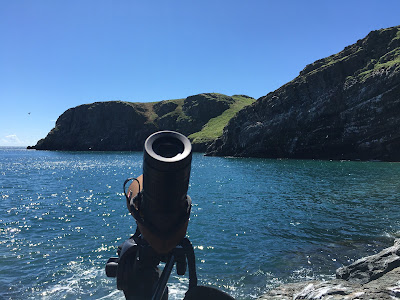It’s a glorious sunny morning here on Skomer – mae’n bendigedig. Two wrens are having a sing-off across the farm courtyard, swallows are chattering as they flit in and out of the visitor centre, and Visitor Officer/ Chief Dumper Wrangler Beth is tightening the ratchet straps on the dumper for another hostel changeover.
In between finishing
my second-last Breeding Bird Survey of the season and setting off to morning boats
to meet oncoming visitors, time for a whistlestop update on the month that was…
The past fortnight has been dominated by seabird counts. Visitors to the island might have noticed members of the team variously perched on rocky outposts staring down scopes, or out on the boat trying to keep binoculars steady as we survey the cliffs. We’ve been joined by ever-enthusiastic seabird volunteer Becci, who as well as being a dab hand at the tiller seems to have a knack for always knowing the right moment to offer a biscuit.
 |
| Becci at the helm |
 |
| Beth counting guillemots |
 |
| Skomer from the sea |
 |
| Leighton and Kelda |
In previous
years, we’ve counted all cliff-nesting species from 1st June,
completing two full counts within three weeks. A recent change in the
methodology moved the start date for guillemots and razorbills to the median
guillemot egg-lay date: this year, the 17th of May. We hope this
will more accurately reflect the numbers of auks breeding on Skomer’s cliffs. Unfortunately,
the weather was not particularly obliging to begin with, with strong winds and
then thick fog scuppering many of our initial attempts. As of yesterday though,
we’ve officially finished the first count (to our great relief!). Now for count
2…
 |
| Using our new Leica scope to count South Stream |
 |
| A moment of triumph - first count of Bull Hole |
We’ve also
been finishing our final round of Breeding Bird Surveys, which allow us to map
breeding activity across the island. We follow the same transects four times
from April to early June – this year, a spell of good weather in March meant we
also did a preliminary survey. It’ll be interesting to put all the maps
together – it’s a bit like piecing together a jigsaw. Whilst sorry to farewell
my transects for the year, I confess to some relief that I can leave the gull
colonies undisturbed – for their sakes and my own. Their aim is improving, and
I only have so many clean clothes…
 |
| Gulls with good aim! |
Their
increased territorial behaviour can be put down to parenthood – there are
chicks everywhere on the island just now, from our now quite well-grown moorhen
adolescents at Moorey Mere to brand new razorbill chicks, to the fluffy
dinosaurs that are great black-backed gull chicks. Our hearts were in our
mouths this week when we discovered eight unaccompanied mallard ducklings
huddled together near the boat shed at North Haven. Fortunately, mama duck eventually
appeared, leading her small brood out to sea. A perilous journey – but who
knows? They might just make it…
 |
| Razorbill chick by Simon Davies |
 |
| Lesser black-backed gull chick |
Bird
highlights of the month included two shrikes in two days – a smart red-backed
shrike near the farm (18th May), spotted by a sharp-eyed hostel
guest, and then a very obliging woodchat shrike (19th May), who
settled in for a few days near the Moorey Mere hide. Warden Leighton then spotted
a nightjar being mobbed by rock pipits in North Haven on the 24th.
Yellow wagtails were seen on the 13th and 14th May, and
pied flycatcher and whinchat on the 15th May, along with good
numbers of spotted flycatchers throughout the month. We’ve had a few cuckoos
coming through as well, with one calling two nights ago in North Valley – my
first of the year, and always a delight.
 |
| Woodchat shrike and half of a bee |
Meanwhile, Skomer’s weekly volunteers have been busy keeping the island ticking over. In addition to the usual fare of cleaning, helping with boats and walking and talking to visitors, they’ve been scything paths, whipping up shelves, spotting cetaceans and assisting with yard clearance. Many thanks to them all – we’d be quite lost without you.
For now,
time to pick up the VHF radio and head to morning boats – with hopes to be able
to write more soon.
- - Ceris,
Assistant Warden
 |
| Skomer Head turning pink with sea thrift |
 |
| South Stream from above |








